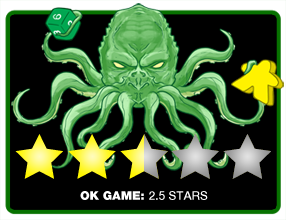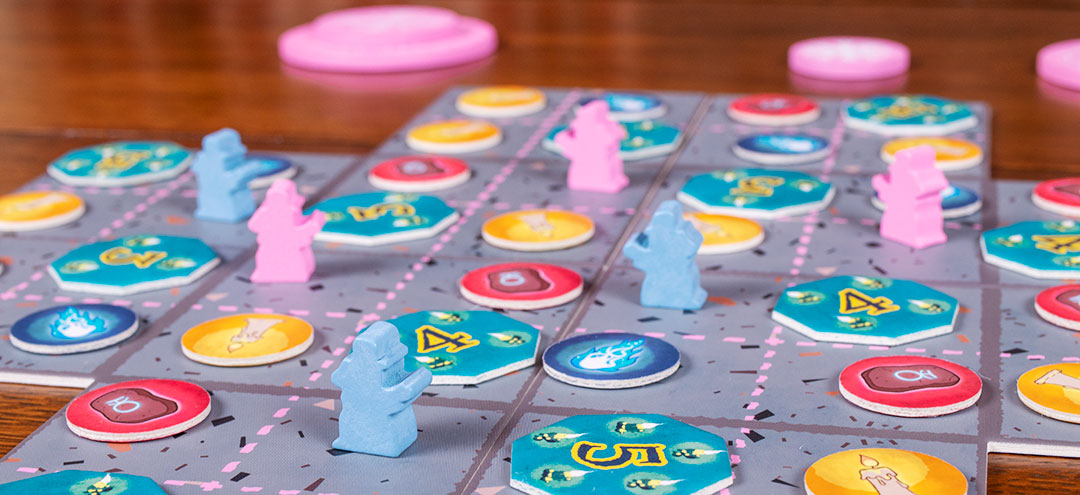 There are some themes that I enjoy so much I don’t care if the market is oversaturated with them. Age of Sail and tall ships? I’m in. Star Wars. Give me more! And Lovecraftian Cthulhu goodness. Sign me up.
There are some themes that I enjoy so much I don’t care if the market is oversaturated with them. Age of Sail and tall ships? I’m in. Star Wars. Give me more! And Lovecraftian Cthulhu goodness. Sign me up.
Today, we are going to be looking at Towers of Äm’härb from Moaideas Game Design. This competitive game seeks to have players controlling altars to unleash their cult’s ancient evil one. Take some area control, a unique tower mechanic, and sprinkle in unique god powers. Sound fun? Let’s find out!
Gameplay Overview:
The Towers of Äm’härb is played over nine rounds in which players are placing their disciples on the board trying to control altars (worth 3-5 points each). A player’s turn takes place over 3 phases:
- Tower Phase: Move one of your four discs to a new area. The game board is divided into 4 vertical columns (from your perspective). And whichever area you place your disk below, that’s your active area for the round. There are placement rules like you can only move the top disc in a stack or you can’t place a larger disc onto a smaller one.
- Power Phase: You can optionally pay 2 resources of a matching color to activate your god’s power.
- Disciple Phase: In the active area, place either a priest or a cultist in an empty space (only containing a resource token). The cost to place a unit is equal to the number of other disciples in the surrounding spaces, minus the height of your tower. So, if the space you wanted to place a cultist had 3 disciples surrounding it, and you had two discs stacked in that area, it would cost you 1 resource.
Turns go by in this manner until all disciples have been placed. To score, players check to see who has the most strength of disciples surrounding an altar (priests are worth three, cultists are worth one), with the points going to the player with the highest total power. After all altars are scored, the player with the most points wins.

Game Experience:
Towers of Äm’härb had a lot of potential to be a really fun game. It has a Cthulhu theme, which I’m always down for, and the Tower of Hanoi mechanic seemed like a really neat idea to use in a game. Unfortunately, the game didn’t quite live up to its potential.
First, let’s talk about the components. I had high hopes when I saw the cool box cover. It had a creepy Lovecraftian vibe, along with a hidden glow in the dark Cthulhu (a really neat idea). Inside, however, was a bit of a mixed bag of components. The art for the gods was highly stylized, but not very impressive. Cthulhu himself looks like he’s on the crapper. The biggest miss was probably the gameboard. It’s a drab grey with what looks to be confetti sprinkled on. I’m not sure what Moaideas was thinking one this one, but it doesn’t look to have been done by a professional illustrator.

OK, so the components are a little meh, but how’s the gameplay? The main interest for me came from how the Tower of Hanoi mechanic was used. I remember playing with this game ages ago, trying to get the discs from one post to another. As cool of a concept that it is, it’s a little lackluster in the game. I think there is probably one column too many for it really to create any tension in the game. I rarely felt like I couldn’t take an action in an area that I wanted to because of tower placement. For the most part, I just went where I needed. The only time I was restricted was if my smallest disk was on the table level. But that maybe happened once a game, if even. Had there only been three columns, I would have had to do a lot more strategic planning about using my tower pieces.
But the biggest miss with Towers of Äm’härb must be the lack of interesting decisions to make. The altars are worth 3, 4, or 5 vps. For the most part, you want to go after the higher numbered altars and try to touch more than one if you can. Even the costs to place a disciple were rarely prohibitive. It’s not until the last couple rounds of the game where you even need to think about disciple placement costs. For the most part, your tower level will take care of 1-2 guys, so it’s only the last round or two where the costs can get up to 3-4. Yet at that point, most of the high point altars already have a leader that one more disciple isn’t going to change.

For the god powers…they are fine, for the most part. Without extensive playtesting, I’m loathed to call something unbalanced, but in our games, some seemed to be clearly used more than others. Cthulhu’s power of being able to put down negative altars was nice. But Hastur’s being able to win ties (that you must predict ahead of time) or Nyog Sothep power of being able to rearrange your tower discs felt lackluster at best. One of our players didn’t use a god power in 3 straight games.
Final Thoughts:
Towers of Äm’härb had a lot of good ideas that really just didn’t pan out. The Cthulhu theme was clearly tacked on and the component quality was mediocre at best. The most interesting new mechanic, the Tower of Hanoi, was way too loose to provide any amount of tense decision making. Overall, that’s what the game is lacking. It seems like the choices are obvious and I never really felt like I was making hard decisions on my turn. Go for the high point altar and spend your resource tokens when necessary (which were plentiful). As an area control game, it’s fine. It definitely plays better at the higher player counts, but that’s true of most all area control games.
Final Score: 2.5 Stars – A lot of great ideas that didn’t seem to be fully realized in the gameplay.
 Hits:
Hits:
• The box cover was great
• The gameplay was easy to learn
• Tower of Hanoi was an interesting idea for a game
Misses:
• Decisions in the game seem pretty obvious
• Tower mechanic isn’t fully realized, lacks tension
• Components are a mixed bag
• God powers feel lackluster and unbalanced























